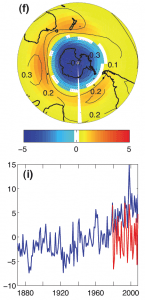l’article du mois – mars 2012
 The Southern Annular Mode seen through weather regimes
The Southern Annular Mode seen through weather regimes
par Benjamin Pohl (CRC) et Nicolas Fauchereau (Council for Scientific and Industrial Research / university of Cape Town, South Africa)
This article investigates the prominent features of the Southern Hemisphere (south of 20°S) atmospheric circulation when extracted using EOF analysis and a k-means clustering algorithm. The focus is on the Southern Annular Mode (SAM), the nature of its recent trend and the zonal symmetry of associated spatial patterns. We use the NCEP2 reanalyses (period 1979-2009), to obtain robust patterns over the recent years, and the Twentieth Century Reanalyses (period 1871-2008), to document decadal changes. We also present a comparison of these signals against station-based reconstruction of the SAM index and a gridded interpolated dataset (HadSLP2).
- extrait:
- lien_externe:
- kc_data:
- a:8:{i:0;s:0:"";s:4:"mode";s:0:"";s:3:"css";s:0:"";s:9:"max_width";s:0:"";s:7:"classes";s:0:"";s:9:"thumbnail";s:0:"";s:9:"collapsed";s:0:"";s:9:"optimized";s:0:"";}
- kc_raw_content:
 The Southern Annular Mode seen through weather regimes
The Southern Annular Mode seen through weather regimespar Benjamin Pohl (CRC) et Nicolas Fauchereau (Council for Scientific and Industrial Research / university of Cape Town, South Africa)
Accepté dans la revue Journal of ClimateThis article investigates the prominent features of the Southern Hemisphere (south of 20°S) atmospheric circulation when extracted using EOF analysis and a k-means clustering algorithm. The focus is on the Southern Annular Mode (SAM), the nature of its recent trend and the zonal symmetry of associated spatial patterns. We use the NCEP2 reanalyses (period 1979-2009), to obtain robust patterns over the recent years, and the Twentieth Century Reanalyses (period 1871-2008), to document decadal changes. We also present a comparison of these signals against station-based reconstruction of the SAM index and a gridded interpolated dataset (HadSLP2).
Over their common period, both reanalyses are in fair agreement, both in terms of spatial patterns and temporal variability. In particular, both datasets show weather regimes that can be interpreted as the opposite phases of the SAM. At the decacal timescale, we show that the trend towards the positive SAM phase (as inferred from usual index) is related more to an increase in the frequency of clusters corresponding to the positive phase, with little changes in the frequency of the negative SAM events. Similarly, the long-term tropospheric warming trend already discussed in the literature is shown to be related more to a decrease in the number of abnormally cold days, with little changes in the number of abnormally warm days. The cluster analysis allows then to complement descriptions based on simple indexes or EOF decompositions, highlighting the non-linear nature of the decadal changes in the Southern Hemisphere atmospheric circulation and temperature.
